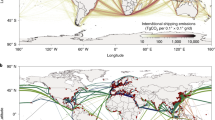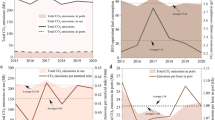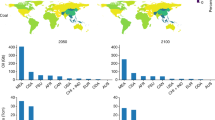Abstract
Uncertainties on the global availability and affordability of alternative marine fuels are stalling the shipping sector’s decarbonization course. Several candidate measures are being discussed at the International Maritime Organization, including market-based measures (MBMs) and environmental policies such as carbon taxes and emissions trading systems, as means to decarbonize. Their implementation increases the cost of fossil fuel consumption and provides fiscal incentives to shipping stakeholders to reduce their greenhouse gas emissions. MBMs can bridge the price gap between alternative and conventional fuels and generate revenues for funding the up-scaling of alternative fuels’ production, storage and distribution facilities and, thus, enhance their availability. By estimating the fuels’ implementation and operational costs and carbon abatement potential, this study calculates marginal abatement costs and estimates the level of carbon pricing needed to render investments into alternative fuels cost-effective. The results can assist policymakers in establishing robust and effective maritime decarbonization policies.
This is a preview of subscription content, access via your institution
Access options
Access Nature and 54 other Nature Portfolio journals
Get Nature+, our best-value online-access subscription
$29.99 / 30 days
cancel any time
Subscribe to this journal
Receive 12 digital issues and online access to articles
$119.00 per year
only $9.92 per issue
Buy this article
- Purchase on Springer Link
- Instant access to full article PDF
Prices may be subject to local taxes which are calculated during checkout






Similar content being viewed by others
Data availability
The data set is included in the online version of the published article and its Supplementary Information. Source data are provided with this paper.
Change history
29 August 2023
A Correction to this paper has been published: https://doi.org/10.1038/s41560-023-01360-2
References
Marine Environmental Protection Committee, IMO. Revised IMO Strategy on reduction of GHG emissions from ships, resolution MEPC.377 (80). MEPC 80/WP.12 annex 11 International Maritime Organization https://www.imo.org/en/MediaCentre/PressBriefings/pages/Revised-GHG-reduction-strategy-for-global-shipping-adopted-.aspx (2023).
Faber, J. et al. Fourth IMO greenhouse gas study 2020. International Maritime Organization https://www.imo.org/en/ourwork/Environment/Pages/Fourth-IMO-Greenhouse-Gas-Study-2020.aspx (2020).
Review of maritime report 2021. United Nations Conference on Trade and Development https://unctad.org/webflyer/review-maritime-transport-2021 (2021).
Shi, Y. Reducing greenhouse gas emissions from international shipping: is it time to consider market-based measures? Mar. Policy 64, 123–134 (2016).
Tanaka, H. & Okada, A. Effects of market-based measures on a shipping company: using an optimal control approach for long-term modeling. Res. Transp. Econ. 73, 63–71 (2019).
Wang, X., Norstad, I., Fagerholt, K. & Christiansen, M. in Sustainable Shipping: a Cross-disciplinary View (ed. Psaraftis, H. N.) pp 285–306 (Springer, 2019).
Lagouvardou, S., Psaraftis, H. N. & Zis, T. A literature survey on market-based measures for the decarbonization of shipping. Sustainability 12, 3953 (2020).
Ashrafi, M., Lister, J. & Gillen, D. Toward a harmonization of sustainability criteria for alternative marine fuels. Mar. Transp. Res. 3, 100052 (2022).
Lindstad, E., Gamlem, G. M., Rialland, A., & Valland, A. Assessment of alternative fuels and engine technologies to reduce GHG. In Proc. SNAME Maritime Convention 2021 https://doi.org/10.5957/SMC-2021-099 (2021).
Korberg, AndreiDavid, Brynolf, S., Grahn, M. & Ridjan Skov, I. Techno-economic assessment of advanced fuels and propulsion systems in future fossil-free ships. Renew. Sustain. Energy Rev. 142, 110861 (2021).
Lagemann, B., Lindstad, E., Fagerholt, K., Rialland, A. & Ove Erikstad, S. Optimal ship lifetime fuel and power system selection. Transp. Res. D 102, 103145 (2022).
Wang, Y. & Wright, L. A. A comparative review of alternative fuels for the maritime sector: economic, technology, and policy challenges for clean energy implementation. World 2, 456–481 (2021).
McKinlay, C. J., Turnock, S. R. & Hudson, D. A. Route to zero emission shipping: hydrogen, ammonia or methanol? Int. J. Hydrogen Energ. 46, 28282–28297 (2021).
Xing, H., Stuart, C., Spence, S. & Chen, H. Alternative fuel options for low carbon maritime transportation: pathways to 2050. J. Clean. Prod. 297, 126651 (2021).
Nair, A. & Acciaro, M. Alternative fuels for shipping: optimising fleet composition under environmental and economic constraints. Int. J. Transp. Econ. 45, 439–460 (2018).
Kesicki, F., Decomposing Long-Run Carbon Abatement Cost Curves – Robustness and Uncertainty. Doctoral thesis, University College London (2012).
IPCC. Climate Change 2001: Synthesis Report. A Contribution of Working Groups I, II and III to the Third Assessment Report of the Intergovernmental Panel on Climate Change (Cambridge Univ. Press, 2001).
Ibrahim, N. & Kennedy, C. A methodology for constructing marginal abatement cost curves for climate action in cities. Energies 9, 227 (2016).
Newell, R. G. & Stavins, R. N. Cost heterogeneity and the potential savings from market-based policies. J. Regul. Econ. 23, 43–59 (2003).
Requate, T. Dynamic incentives by environmental policy instruments – a survey. Ecol. Econ. 54, 175–195 (2005).
Kesicki, F. & Ekins, P. Marginal abatement cost curves: a call for caution. Clim. Policy 12, 219–236 (2012).
Huang, ShihpingKevin, Kuo, L. & Chou, KueiLan The applicability of marginal abatement cost approach: a comprehensive review. J. Clean. Prod. 127, 59–71 (2016).
IMarEST. Marginal Abatement Costs and Cost-Effectiveness of Energy-Efficiency Measures, MEPC 62/INF.7 (Marine Environmental Protection Committee, International Maritime Organization, 2011).
Eide, M. S., Endresen, Øyvind, Skjong, R., Longva, T. & Alvik, S. Cost-effectiveness assessment of CO2 reducing measures in shipping. Mar. Policy Manage. 36, 367–384 (2009).
Franc, P. & Sutto, L. Impact analysis on shipping lines and European ports of a cap-and-trade system on CO2 emissions in maritime transport. Mar. Policy Manage. 41, 61–78 (2014).
Longva, T., Eide, M. S. & Skjong, R. Determining a required energy efficiency design index level for new ships based on a cost-effectiveness criterion. Mar. Policy Manage. 37, 129–143 (2010).
Smith, T. et al. CO2 emissions from international shipping possible reduction targets and their associated pathways. UMAS https://www.u-mas.co.uk/wp-content/uploads/2020/11/Smith-et-al.-2016-Co2-emissions-in-shipping-targets-pathways.pdf (2016).
Buhaug, Øyvind et al. Second IMO greenhouse gas study 2009, a technical report. International Maritime Organization https://www.imo.org/en/OurWork/Environment/Pages/Greenhouse-Gas-Study-2009.aspx (2009).
Faber, J., Behrends, B. & Nelissen, D., Analysis of GHG marginal abatement cost curves. CE Delft https://cedelft.eu/publications/analysis-of-ghg-marginal-abatement-cost-curves/ (2011).
Faber, J. et al. Technical support for European action to reducing greenhouse gas emissions from international maritime transport. European Union https://climate.ec.europa.eu/system/files/2016-11/ghg_ships_report_en.pdf (2009).
DNV. DNV low carbon shipping towards 2050. DNV https://www.dnv.com/Publications/low-carbon-shipping-towards-2050-93579 (2009).
Hu, H., Yuan, J. & Nian, V. Development of a multi-objective decision-making method to evaluate correlated decarbonization measures under uncertainty – the example of international shipping. Transp. Policy 82, 148–157 (2019).
Nepomuceno de Oliveira, MA., Szklo, A. & Castelo Branco, D. A. Implementation of maritime transport mitigation measures according to their marginal abatement costs and their mitigation potentials. Energ. Policy 160, 112699 (2022).
Lindstad, E., Lagemann, B., Rialland, A., Gamlem, G. M. & Valland, A. Reduction of maritime GHG emissions and the potential role of e-fuels. Transp. Res. D 101, 103075 (2021).
Kyprianidou, I., Worrell, E. & Charalambides, A. The cost-effectiveness of CO2 mitigation measures for the decarbonisation of shipping. The case study of a globally operating ship-management company. J. Clean. Prod. 316, 128094 (2021).
Englert, D., Losos, A., Raucci, C. & Smith, T. Volume 1: the potential of zero carbon bunker fuels in developing countries. World Bank https://openknowledge.worldbank.org/handle/10986/35435 (2021).
Li, S., Tong, L., Xing, J. & Zhou, Y. The market for electric vehicles: indirect network effects and policy design. J. Assoc. Environ. Resour. Econ. 4, 89–133 (2017).
Lagemann, B. et al. Optimal ship lifetime fuel and power system selection under uncertainty. Transp. Res, D 119, 103748 (2023).
Ship charter rates. Handybulk https://www.handybulk.com/ship-charter-rates/ (2022).
Newbuilding orders on positive ground. Hellenic Shipping News https://www.hellenicshippingnews.com/newbuilding-orders-on-positive-ground/ (2022).
Levander, K., System Based Ship Design, NTNU Marine Technology. Compendium (SeaKey Naval Architecture, 2012).
Preparing container vessels for conversion to green fuels. Mærsk Mc-Kinney Møller Center for Zero Carbon Shipping https://www.zerocarbonshipping.com/publications/preparing-container-vessels-for-conversion-to-green-fuels-2/ (2022).
Comer, B., Chen, C. & Rutherford, D., Relating short-term measures to IMO’s minimum 2050 emissions reduction target. ICCT https://theicct.org/publication/relating-short-term-measures-to-imos-minimum-2050-emissions-reduction-target/ (2018).
Availability of sustainable biofuels. The Sustainable Shipping Initiative https://www.sustainableshipping.org/resources/availability-of-sustainable-biofuels/ (2021).
Al-Aboosi, F. Y., El-Halwagi, M. M., Moore, M. & Nielsen, R. B. Renewable ammonia as an alternative fuel for the shipping industry. Curr. Opin. Chem. Eng. 31, 100670 (2021).
Atilhan, S. et al. Green hydrogen as an alternative fuel for the shipping industry. Curr. Opin. Chem. Eng. 31, 100668 (2021).
An industrial view of ammonia as a marine fuel. Hanfia, Alfa Laval, Vestas, Haldor Topsøe and Gamesa, Siemens Ammonfuel https://hafniabw.com/wp-content/uploads/2020/08/Ammonfuel-Report-an-industrial-view-of-ammonia-as-a-marine-fuel.pdf (2020).
The future of hydrogen. IEA https://www.iea.org/reports/the-future-of-hydrogen (2019).
Acknowledgements
We are grateful for the funding from DTU and Orient’s Fond under the MBM SUSHI project and the Research Council of Norway under the SFI Smart Maritime (project no. 237917).
Author information
Authors and Affiliations
Contributions
S.L. contributed to conceptualization, methodology, software, validation, formal analysis, investigation, resources, writing of original draft and visualization. B.L. contributed to methodology, investigation, resources, writing (review and editing) and visualization. H.N.P. contributed to conceptualization, investigation, writing (review and editing), supervision, project administration and funding acquisition. E.L. contributed to investigation, resources and supervision. S.O.E. contributed to writing (review and editing) and supervision.
Corresponding author
Ethics declarations
Competing interests
The authors declare no competing interests.
Peer review
Peer review information
Nature Energy thanks Akira Okada, Laura Lonza and Eoin O’Keeffe for their contribution to the peer review of this work.
Additional information
Publisher’s note Springer Nature remains neutral with regard to jurisdictional claims in published maps and institutional affiliations.
Supplementary information
Supplementary Information
Supplementary Tables 3 and 4.
Source data
Source Data Fig. 1
MAC calculations for newbuilding vessel.
Source Data Fig. 2
MAC calculations for 5 year retrofit diesel ICE.
Source Data Fig. 3
MAC calculations for 10 year retrofit diesel ICE.
Source Data Fig. 4
MAC calculations for 5 year retrofit LNG ICE.
Source Data Fig. 5
MAC calculations for 10 year retrofit LNG ICE.
Rights and permissions
Springer Nature or its licensor (e.g. a society or other partner) holds exclusive rights to this article under a publishing agreement with the author(s) or other rightsholder(s); author self-archiving of the accepted manuscript version of this article is solely governed by the terms of such publishing agreement and applicable law.
About this article
Cite this article
Lagouvardou, S., Lagemann, B., Psaraftis, H.N. et al. Marginal abatement cost of alternative marine fuels and the role of market-based measures. Nat Energy 8, 1209–1220 (2023). https://doi.org/10.1038/s41560-023-01334-4
Received:
Accepted:
Published:
Issue Date:
DOI: https://doi.org/10.1038/s41560-023-01334-4



